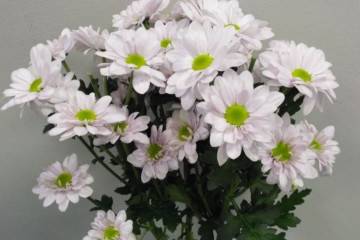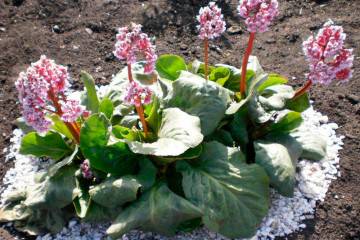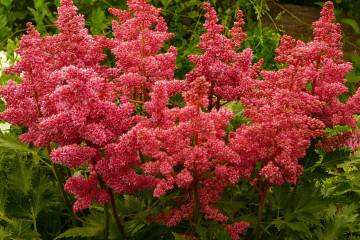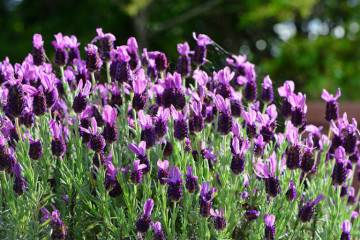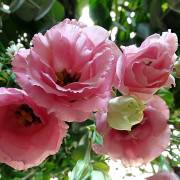Irises - planting and care in the open field
Content:
Irises are ornamental plants that are popular with gardeners due to their bright and spectacular flowering. Flowers are not particularly demanding and whimsical, so even a beginner will be able to ennoble the plot in the country with their help.
Description of the flower
The plant has been known since ancient times. On the 4000-year-old frescoes, drawings of similar colors were recorded. During the Middle Ages, irises adorned the gardens of castles, and then the sites of the townspeople. Today the flower has a peculiar meaning. It is considered a symbol of calmness, resilience and masculinity.
From the Greek language, the word "iris" literally translates as "rainbow". There are many varieties of the plant, which are painted in a variety of bright shades of all colors of the rainbow.
Popular varieties of irises:
- bearded;
- Siberian;
- dwarf;
- Japanese.
Irises: planting and care in the open field
Planting irises in open ground is a simple, but very important process, during which it is worth following the instructions. Mistakes that can be made as a result of improper planting will affect the growth and development of the flower.
Therefore, it is necessary to familiarize yourself in more detail with the variety of purchased seedlings.
How, when and where to plant irises
Before planting, it is important to determine the location of the flower bed. It is worth taking care of drainage in advance. The moisture that stagnates will harm the root system, leading to decay.
The cockerel needs warm sunlight. The area with flowers should be located in an open area. In this case, it is worth protecting the flower from drafts and temperature extremes.
Irises prefer neutral soil. In an acidic environment, plants do not bloom and are often attacked by parasites. If there is no choice, then the mixture can be prepared independently by adding sand and peat to the existing soil.
Planting a plant is carried out mainly in two ways - by seeds or bulbs.
Planting irises in summer
Often, the plant is planted in the middle of summer. Until winter, irises lay buds and bloom successfully by the next period.
Planting irises in autumn
A few weeks before the first frost, the iris bulbs are immersed in the ground, which has not yet cooled down. It is best to do this in early October so that the iris can take root. Otherwise, there is a high probability that the culture will die.
Planting irises in spring
Bulbous irises can be planted in spring. You can start the procedure as early as March, when the soil has warmed up to 10 ° C. In this case, flowering will occur in June or next year.
How to plant bulbous irises
Planting of bulbous whales is done advantageously in the spring.

Iris bulbs are located in the top layer of the soil, so they should not be buried deep when planting.
It is worth considering that this method is only suitable for certain varieties and varieties.
Step-by-step planting process
To complete the planting procedure, you need to follow two simple steps:
- Form a hole 10 cm deep and place the onion in it.
- Cover it with earth and pour over settled water.
Growing irises from seeds
You can sow iris seeds in March or September. The best option would be the spring period, because in the fall frosts can begin abruptly, which will lead to the death of the plant.
Seeds must be prepared in advance for planting. It is best to put them in a damp cloth and some sort of container. The container must be placed in the freezer and transferred to the heat after a month. The first shoots will need to be transplanted into soil and provided with additional lighting. It is recommended to transplant seedlings into open ground in May.
How to care for irises in the garden
Iris requirements are minimal. If you follow the instructions on the rules for planting and caring for irises, then you can easily grow beautiful ornamental plants in your flower bed.

After planting, it is imperative to weed the flower bed from weeds several times and loosen the soil
Watering mode
Iris flowers love moisture, so on dry days they need to be watered daily. In other cases, 3 times a week will be enough.
How to feed irises in spring for lush flowering in the garden
To achieve lush flowering, it is recommended to apply mineral fertilizers to the soil. Top dressing is usually done three times. The first time in early spring, then at the time when the buds begin to form, and the last time after the iris has faded.
For each feeding, supplements of different composition are selected. For spring, nitrogen, potassium and phosphorus fertilizers are suitable. The second time the plant needs more nitrogen and potassium. And after the end of flowering, it is worth adding more phosphorus to the soil.
Features of care during the flowering period
During the flowering period, the plants are especially stretched in height. To prevent the wind from breaking the stems, it is recommended to tie the irises to the support.
Preparing for winter
In order for the plant to successfully survive the winter, it is necessary to perform a number of measures aimed at preparing for wintering.
First, you need to prune the stems. This procedure will help to preserve the spectacular appearance of the plant for a long time. Secondly, do not forget to make mineral fertilizing, because in winter the plant will receive less nutrients. Thirdly, killer whales need to be hidden from the cold for the winter. For this, film or polyethylene is suitable, which will allow you to keep warm. The shelter is removed in the spring, when the possibility of frost is minimized.
Some varieties are recommended to be dug out for the winter. They need to be dried and the roots hidden in a dry ventilated room. After the soil warms up to at least 10 ° C in spring, it will be possible to transplant the roots into the ground.
Pruning
After the irises have faded, pruning is necessary. To do this, with a sharp tool, you need to remove flowers that have ceased to bloom, along with a receptacle or even a stem. The procedure should be repeated in the spring, cutting off the leaves that have withered or dried up.
Reproduction
Irises are propagated by seeds or by dividing the rhizome.
After the bud has wilted, a gauze bag is put on the seed box, which is fixed on the stem. Thus, when the capsule is opened, the seeds remain inside the bag, and it will not be difficult to multiply them in the future.
The second method suggests dividing the rhizome into 2 or 3 parts and planting each fragment separately.
When to replant irises after flowering
The best time to transplant irises is the period that begins after the end of flowering. The plant is removed from the ground along with the soil and transferred to a new location. Spring transplants often work well. It should be started when young small leaves have already formed.
How to plant irises correctly
To preserve the decorativeness of the plant, you need to replant it every 6 years. The easiest way to do it is with rhizome irises. After they have faded, you need to wait 2-3 weeks, then proceed with the transplant. The rhizome must be carefully removed from the ground, rinsed and divided into several parts with a sharp tool.
Planting material can be stored for 2 weeks in a warm and dry place.
There is no definite answer to the question of when is it better to plant irises. Some growers prefer to do this in the fall, while others in the spring. In the first case, it is important to plan everything so that frosts do not have time to affect the plants.
Iris transplantation is often scheduled for the fall, or rather, at the end of September. In the ground, you need to form a hole, pour some sand on the bottom, put a root on it, tilting the seedling to the south, and fill it with special soil. Upon completion of the work, it is important not to forget to water the planted plant.
Transplanting irises to another place in the summer is quite simple. To do this, you need to very carefully remove the flower from the soil, trying not to damage the root system, immerse it in a previously prepared hole and water it with water.
Iris diseases
Like any other crop, iris is prone to disease and is susceptible to parasites.
Mosaic is one of the most common irises diseases. A viral disease manifests itself in the form of stripes or spots on the leaf plates of the plant. The cause of its occurrence is the aphid parasite carrier.
To protect the plant from disease, you need to regularly inspect the flowers for infection and remove dubious specimens in a timely manner.
No less dangerous common disease is bacterial rot. It usually appears after wintering in the form of dark brown spots. Areas of the plant are treated with potassium permanganate.

All diseases of the flower affect the appearance of the plates, therefore it is necessary to frequently examine the cockerels for rotting or drying.
To get rid of the above problems will help special preparations for processing, which are sold in flower shops.
Pests
Pests and various parasites often cause problems. Scoops, iris fly, thrips, slugs and bear destroy beautiful flowers, making them wither. The fight against each of the types of pests must be approached in different ways:
- the iris fly penetrates into the bud, begins to devour it, thereby causing rotting. In this case, you need to play it safe in advance and, as a preventive measure, treat the flower with special insecticides;
- thrips live on leaf blades, which causes them to turn yellow and wilt. As a result, the flower buds are damaged and the flower does not bloom. For treatment, karbofos and laundry soap are used;
- slugs spread disease and spoil the leaves of the flower.They can be removed from the plant manually and treated with superphosphate;
- the bear attacks the very roots of the plant. In advance, you need to add the shell of a chicken egg to the soil, and if moves are found, pour in a solution made from water and soap or washing powder;
- scoops cause irreparable damage to the iris. They eat away the peduncle, which is why the plant begins to turn yellow. Only prevention in the form of treatment with karbofos can help.
Why irises don't bloom
The lack of flowering can be caused by an insufficient amount of minerals in the soil or a lack of moisture. Often irises cannot bloom due to the fact that they are sick or are under the influence of parasites.
Irises are ornamental plants that, thanks to their wide palette of colors and shades, allow anyone to find the best option for themselves. Anyone who is familiar with the instructions and rules prescribed for each variety can grow and care for flowers.





